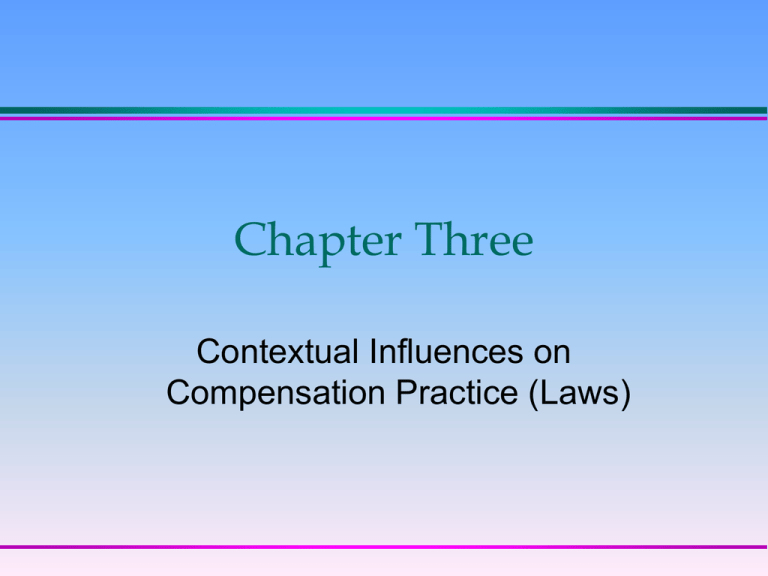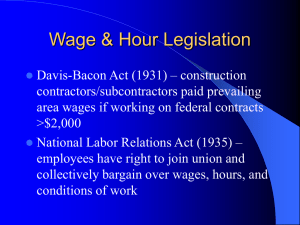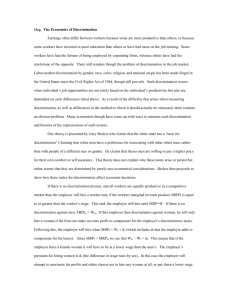Ch. 3: Contextual influences
advertisement

Chapter Three Contextual Influences on Compensation Practice (Laws) Exhibit 3-1 Employers’, Employees’, and Government’s Goals Employers Government Employees (and Unions) Laws Affecting Compensation Levels of Laws » Federal, State, Local Federal Laws: Income continuity, safety, work hours: » FLSA, Social Security Act, Portal-to-Portal Act, Work Hours and Safety Standards Act, Local Area Wage Pay discrimination » Equal Pay, Title VII of Civil Rights Act of 1964, ADEA (and OWBPA), Executive Orders, Accommodating disabilities and family needs » Pregnancy Discrimination Act, ADA, FMLA Prevailing wage laws Income continuity, safety, work hours: Fair Labor Standards Act Minimum wage Hours of work (overtime provisions) Also: Child labor laws, Equal pay laws* Covered and not-covered companies Exempt vs. non-exempt positions » Most positions are non-exempt » Executives, administrative, professionals, and some others are exempt Exhibit 3-2 Differences Between Annual Minimum Wage Earnings and Annual Poverty Thresholds for Selected Years YEAR 1980 1986 1989 1990 1992 1994 ANNUAL MINIMUM WAGE EARNINGS (hourly min. wage ANNUAL POVERTY x 40 hr/week x THRESHOLD 52 weeks) (family of three) DIFFERENCE FED. MINIMUM A B HOURLY WAGE A-B $3.10 $3.35 $3.35 $3.80 $4.25 $4.25 $6,448 $6,968 $6,968 $7,904 $8,840 $8,840 $6,565 $8,737 $9,885 $10,419 $11,186 $11,542 -$ 117 -$1,769 -$2,917 -$2,515 -$2,346 -$2,702 Source: US Dept. of Commerce, Statistical abstracts of the US, 115th ed. (Washington, DC: US Government Printing Office, 1995). Exhibit 3-10 Average Weekly Earnings by Industry Group, 1980 to 1994 INDUSTRY 1980 1985 1990 1993 1994 Construction Manufacturing $397 $368 $520 $464 $603 $526 $647 $552 $666 $570 Transportation, public utilities Wholesale trade Mining Finance, insurance, real estate Service $351 $267 $235 $210 $191 $450 $351 $299 $289 $257 $505 $411 $345 $357 $319 $540 $448 $374 $406 $351 $554 $460 $385 $424 $360 Retail trade $147 $175 $194 $210 $216 Source: U.S. Dept. of Commerce, Statistical abstracts of the United States, 115th ed. (Washington, D.C.: U.S. Government Printing Office, 1995). Exhibit 3-5 Compensable Activities That Precede and Follow Primary Work Activities The time spent on the activity was for the employee’s benefit. The employer controlled the amount of time spent. The time involved is categorized as “suffered and permitted,” meaning that the employer knew the employee was working on incidental tasks either before or after the scheduled tour of duty. The time spent was requested by the employer. The time spent is an integral part of the employee’s principal duties. The employer has a union contract with employees providing such compensation, or, as a matter of custom or practice, the employer has compensated the activities in the past. Exhibit 3-4 FLSA Exemption Criteria for Executive, Administrative, and Professional Employees (1 of 3) Executive Employees » Primary duties include managing the organization » Regularly supervise the work of two or more fulltime employees » Authority to hire, promote, and discharge employees » Regularly use discretion as part of typical work duties » Devote at least 80 percent of work time to fulfilling the previous activities Exhibit 3-4 FLSA Exemption Criteria for Executive, Administrative, and Professional Employees (2 of 3) Administrative Employees » Perform nonmanual work directly related to management operations » Regularly use discretion beyond clerical duties » Perform specialized or technical work, or perform special assignments with only general supervision » Devote at least 80 percent of work time to fulfilling the previous activities Exhibit 3-4 FLSA Exemption Criteria for Executive, Administrative, and Professional Employees (3 of 3) Professional Employees » Primary work requires advanced knowledge in a field of science or learning, including work that requires regular use of discretion and independent judgment, or » Primary work requires inventiveness, imagination, or talent in a recognized field or artistic endeavor Source: 29 Code of Federal Regulations, Sec. 541.3 29; Sec. 541.1. Exhibit 3-3 Six Defining Factors of Trainee for the FLSA The training, even though it includes actual operation of the employers’ facilities, is similar to that which would be provided in a vocational school. The training is for the benefit of the trainee. The trainee does not displace regular employees but works under closer supervision. The employer providing the training gains no immediate advantage from the trainees’ activities; on occasion, the employer’s operation may in fact be hindered. The trainee is not guaranteed a job at the completion of the training. The employer and the trainee understand that the employer is not obligated to pay wages during the training period. Source: J.E. Kalet, Primer on wage and hour laws (Washington, DC: Bureau of National Affairs, 1987). Pay Discrimination Equal Pay Act 1963 - Equal Jobs “Equal pay for equal work:” Equal pay for men and women performing substantially equal work. » » » » Skill: Experience, training, education, ability Effort: Mental or physical, amount (not type) Responsibility: Accountability Working conditions: Physical surroundings and hazards-inside/outside, heat, cold, poor ventilation » Skill/effort/responsibility must be substantially greater, tasks must consume a significant amount of time for all employees, must have a value commensurate with pay differential » Based on job contents, not title or job description Exhibit 3-6 U.S. Department of Labor Definitions of Compensable Factors Factor Skill Effort Responsibility Working conditions Definition Experience, training, education, and ability as measured by the performance requirements of a job The amount of mental or physical effort expended in the performance of a job The degree of accountability required in the performance of a job The physical surroundings and hazards of a job, including dimensions such as inside versus outside work, heat, cold, and poor ventilation Source: U.S. Department of Labor, Equal pay for equal work under the Fair Labor Standards Act (Washington, D.C.: U.S. Government Printing Office, December 31, 1971). EPA’s Affirmative Defenses Pay differences in equal jobs are allowable due to: » » » » Seniority Merit Quality or quantity of production Any factor other than sex: Shift differentials, temporary assignments, bona fide training programs, differences based on ability, training, or experience, others (justified business reason). » Reverse discrimination may occur if a new pay system is designed and not equally applied to all employees, but not if a one-time adjustment is made for past problems Title VII of CRA of 1964 (&) -Equal or Unequal Jobs Companies with 15+ employees, employment agencies and labor unions. Not U.S. gvt. Prohibits discrimination based on race, creed (religion), color, national origin, sex, or pregnancy in any employment condition: hiring, firing, promotion, transfer, compensation, admission to training. Disparate Treatment: Treating people differently (less favorably) openly or covertly based on protected class (characteristic). Disparate Impact: Treating people equally, but the practices have a differential effect, unless justified or work-related Disparate Treatment Direct discrimination Different standards for different people. Prejudiced actions Intent to discriminate inferred by behavior. Can justify actions by absence of discriminatory intent and reasonable business judgment. Disparate Impact Indirect discrimination Same standards have differing consequences. Neutral, color-blind actions Discrimination shown by statistics; intent need not be present. Can justify pay differences through business necessity. Gender Pay Gap Begins Early Weekly allowance of children 12-under Average weekly wage $7.66 $8.87 $379 $504 Women Men Pay Differences by Race and Sex Average Weekly Earnings Full-time Workers 1990 600 500 400 300 200 Men 100 0 Women White Black Hispanic The Pay Gap - “Male Dom” 900 800 700 600 500 400 300 200 100 0 hr Tc C ol l C on s tr uc tio n g En h ec M Fi n M gr Weekly Earnings 1990 Men Women Pay Gap “Female Dom” Weekly Earnings 1990 700 600 500 400 300 Men 200 Women 100 0 Reg Nurse Elem Tchr Gen Office Sew Mach Management Jobs Weekly Earnings 1989 1000 900 800 700 600 500 400 300 200 100 0 Rel Mgt Med d Ed A Mkt P/LR Fin Ad Pub Exe A d Men Women MBA’s - Top Business Schools 90000 80000 70000 60000 50000 40000 30000 20000 10000 0 Annual Earnings 1990 Corn Berk Mich Dart Stan Roch Colum UCLA Va MIT Men Women Bachelor’s Degree Salary Offers 30000 Marketing Job Offers-Annual Salaries 1992 25000 20000 15000 10000 Men 5000 Women s Sale h Purc R Mkt Buye r d Bran Adv 0 Income by Years of Schooling 60000 50000 Annual Earnings 1990 40000 30000 20000 Men 10000 Women l >Col Col D eg Som e Co l HS Som e HS Elem 0 Income by Education, Race, Sex Annual Earnings 1990 40 35 30 25 W men 20 W women 15 B men 10 B women H men 5 0 H women Some HS HS grad 4yr Coll Changes in Pay Gap 120 100 80 60 40 20 White M Black M Hisp M White W Black W Hisp W 0 1960 1970 1980 1982 1984 1986 1988 1990 Explanations for the Pay Gap-Structural Characteristics Earnings differ among occupations, jobs differ in value, substantial labor force segregation by sex, women disproportionally in jobs that are lower valued and paid. Accounts for 10-40% of gap. Occupations: Clerical vs craft Jobs: Selling: apparel vs boats Glass Ceiling: Job level varies Industries: Service vs. manufacturing Firms: Large vs small Union Membership: Jobs/firms/industries Explanations for the Pay Gap-Individual Characteristics Relate pay differences to differences believed to affect a person’s productivity on the job, that make a person valuable to an employer. Accounts for 0-44%. Experience: 31%, “return on” Seniority (tenure): 40%, “return on” Education: 2%, “return on” Behaviors, other qualifications Together structural and individual explanations account for 30-60% of the wage gap, leaving 40-70% unexplained. Age Discrimination in Employment Act of 1967 (ADEA) Covers private employers with 20+ employees, labor unions with 25+ employees, and employment agencies EEOC enforces this act Protects workers age 40 and older from illegal discrimination in employment practices » Including pay and benefits » Limits to early retirement--must be voluntary Accommodating Disabilities and Family needs Pregnancy Discrimination Act of 1978 » Must not treat pregnancy less favorably than other medical conditions, must treat pregnancy and childbirth as other causes of disability » Leave: must allow credit for previous service, accrued retirement benefits accumulated seniority Accommodating Disabilities and Family Needs, cont’d Americans with Disabilities Act of 1990 (ADA) » Mental or physical disabilities » Reasonable Accommodation Family and Medical Leave Act of 1993 » Job protection in cases of family or medial emergency » 12 weeks of unpaid leave Other Influences Labor unions » National Labor Relations Act (NLRA) – Equality of bargaining power between employees and employers » Compensation issues in collective bargaining – COLA – Spillover effect – Concessionary bargaining Market Influences » Industry effects, capital-intensity






